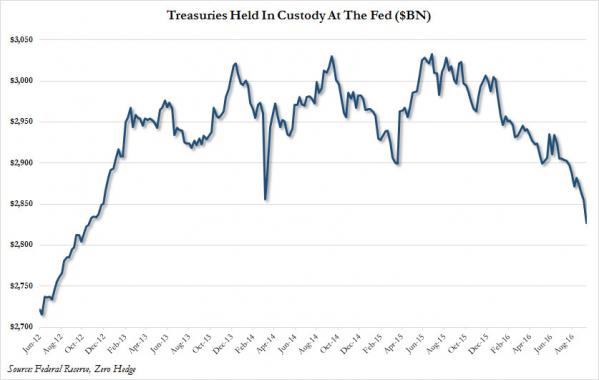One month ago, when we last looked at the Fed’s update of Treasuries held in custody, we noted something troubling: the number dropped sharply, declining by over $17 billion, bringing the total to $2.871 trillion, the lowest amount of Treasuries held by foreigners at the Fed since 2012. One month later, we refresh this chart and find that in the latest weekly update, foreign central banks accelerated their liquidation of US paper held in the Fed’s custody account, which tumbled by $27.5 billion in the past week, the biggest weekly drop since January 2015, pushing the total amount of custodial paper to $2.83 trillion, the lowest since 2012.

Â
Then today, in addition to the Fed’s custody data, we also received the latest monthly Treasury International Capital data, which showed that the troubling trend presented last one month ago, has accelerated. Recall that a month ago, we reported that in the latest 12 months we have observed a not so stealthy, if massive $335 billion in Treasury selling in the period July 2015- June 2016, something truly unprecedented in size and scope.
Fast forward one month, when in the latest monthly update, that of July, we find that what until a month ago was “merely” a record $335 billion in central bank sales in the LTM period ending June 30, one month later, this number has risen to a new all time high $343.4 billion, or well over a third of a trillion in Treasuries sold in the past 12 months.Â

Â
Among the biggest sellers if on a market-price basis, not surprisingly, was China, which in July “sold” $22 billion in US paper (the number is different – the tracked total shows, bringing its total to $1.219 trillion, the lowest total since 2012.

Â
What is becoming increasingly obvious, is that both foreign central banks, sovereign wealth funds, reserve managers, and virtually every other official institution in possession of US paper, is liquidating it at a never before seen pace. In some cases, like China, this is to offset devaluation pressure; in others such as Saudi Arabia, it is to provide the funds needed to offset the collapse of the petrodollar, and to backstop the country’s soaring budget deficit.

